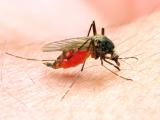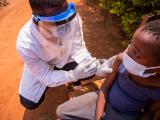Despite the slowly decreasing global malaria burden, US malaria case hit a 40-year high in 2011, part of a rise that likely reflects growth in international travel and lapses in precautions among overseas travelers, the Centers for Disease Control and Prevention (CDC) said in a report today.
The CDC said 1,925 malaria cases were reported in 2011, up 14% from the previous year, and up 48% since 2008. Five of the patients in 2011—the most recent year for which data are available—died from malaria or its complications. The report appeared in Morbidity and Mortality Weekly Report (MMWR).
All but five of the cases were acquired overseas. One was lab acquired, one was transfusion related, two were congenital, and one was cryptic.
Malaria, caused by a parasite transmitted by infected female Anopheles mosquitoes, sickens about 219 million people around the world each year and is linked to about 660,000 deaths. Malaria symptoms can vary, but most patients have fever, often with headache and flulike symptoms. When untreated, the disease can lead to coma, kidney failure, respiratory failure, and death.
A similar rise in imported malaria cases has been seen in the United Kingdom, the CDC said. It warned that imported malaria can reintroduce the disease into areas, such as the United States, where the disease isn't endemic. And the agency added that US environmental conditions could support the life cycle of the parasite and its mosquito carrier.
Nearly two thirds of the patients were infected in West African countries, but for the first time India was the country from which most cases were imported, the CDC said. Seasonal peaks were noted in January and August, which are peak times to African travel destinations for winter and summer holidays, according to the MMWR report.
CDC Director Tom Frieden, MD, said in a statement that US doctors don't often see malaria cases, due to successful malaria elimination efforts in the 1940s. "The increase in malaria cases reminds us that Americans remain vulnerable and must be vigilant against diseases like malaria because our world is so interconnected by travel."
Failure to take prophylaxis recommended for travel to areas where malaria is endemic was a common risk factor, the CDC said. For example, of 929 cases with available information, only 6% said they had followed CDC recommendations for their travel destinations. Of 37 pregnant women who were infected, only 1 took the recommended drug.
Laurence Slutsker, MD, MPH, who directs the CDC's division of parasitic diseases and malaria, said in the statement that most of the illnesses and deaths could have been avoided by taking recommended precautions, which also include using insect repellent, insecticide-treated bed nets, and protective clothing.
"We have made great strides in preventing and controlling malaria around the world," he said. "However, malaria persists in many areas and the use of appropriate prevention measures by travelers is still very important."
People visiting friends and relatives make up a large portion of travelers to those areas, and many believe partial immunity from earlier infection protects them from re-infection. The CDC said those travelers represent an especially difficult population to reach with prevention messages and that evidence-based strategies are needed to target the group and drive down the number of imported malaria cases.
See also:
Nov 1 MMWR surveillance summary
Oct 31 CDC press release





















